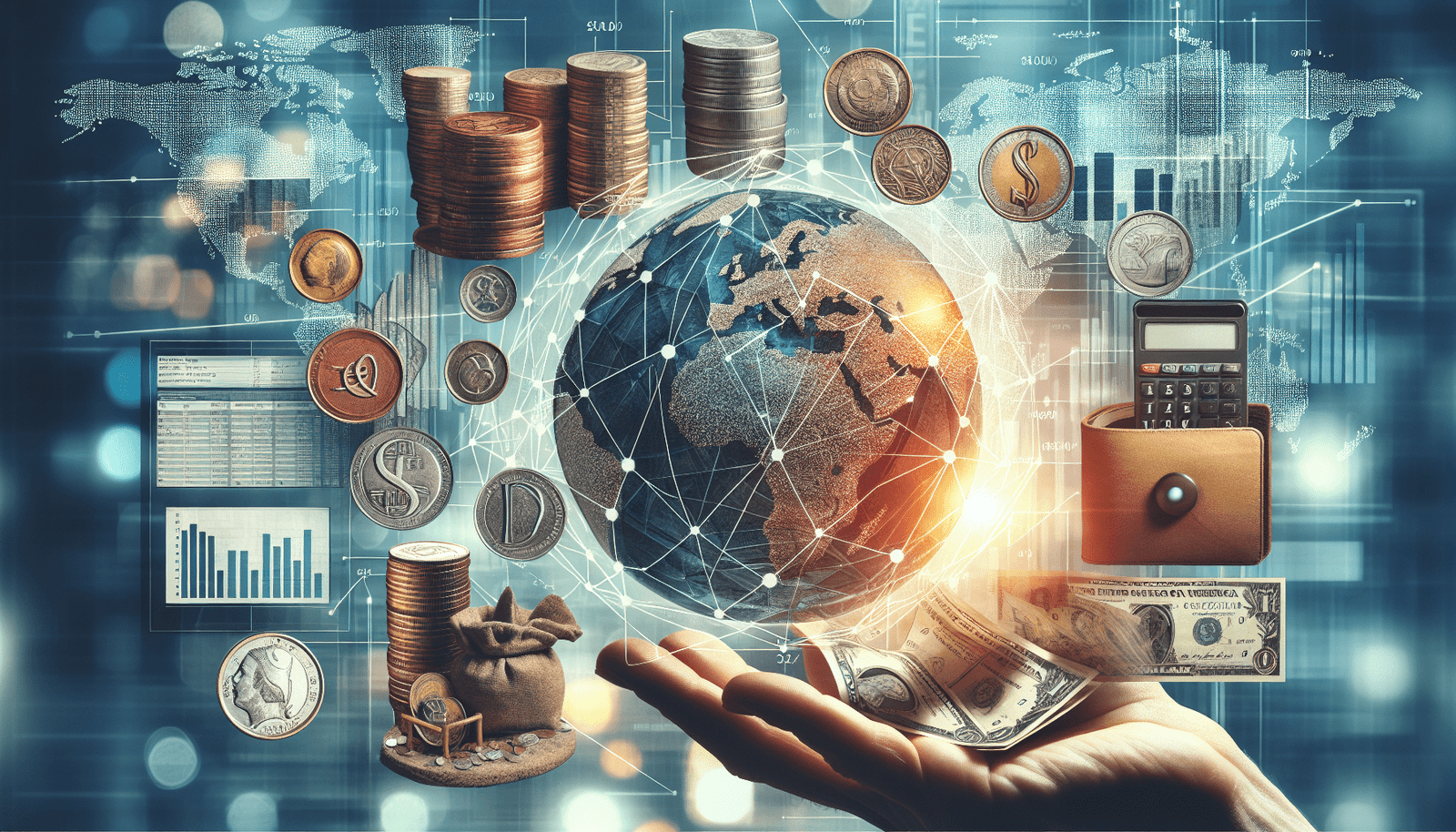Understanding The Basics: How Money Functions In Modern Economies
1. Introduction
In today’s interconnected world, money plays a central role in our daily lives. From buying groceries to paying bills, understanding how money functions in modern economies is essential to navigating the financial landscape. This article aims to shed light on the basics of money, exploring its role as a medium of exchange, unit of account, and store of value. By grasping these fundamental concepts, you will gain a deeper understanding of how money shapes the economy and impacts your own financial decisions.

2. What is Money
Money is an essential component of modern economies that is used to facilitate the exchange of goods and services. It serves as a medium of exchange, unit of account, and store of value. Without money, trading and commerce as we know it would be incredibly difficult and inefficient. Understanding the nature and functions of money is crucial to comprehending the intricacies of the economy.
Money can be defined as any object or record that is widely accepted as a payment for goods and services and repayment of debts within a particular country or socio-economic context. It can take various forms, including physical objects like coins and banknotes, as well as digital representations in the form of electronic money.
2.1 Functions of Money
Money serves three primary functions: a medium of exchange, a unit of account, and a store of value. As a medium of exchange, money facilitates the buying and selling of goods and services by eliminating the need for a direct barter system. It allows for the smooth and efficient transfer of value between parties.
Money also functions as a unit of account, providing a common measure for the value of goods and services. It helps in comparing the worth of different products and enables individuals and businesses to keep track of income, expenses, and profit.
Lastly, money serves as a store of value, allowing individuals to save and accumulate wealth over time. By holding money, people can defer consumption and preserve their purchasing power for future use. However, the value of money can be affected by inflation and other economic factors.
2.2 History of Money
Understanding the history of money can provide insights into how it has evolved and transformed over time. From the barter system to the introduction of coins, paper money, and electronic forms of payment, the journey of money showcases the innovation and development of human civilization.
2.2.1 Barter System
Before the introduction of money, the barter system was an early form of trade where goods and services were exchanged directly. Individuals would trade items they had or services they could provide in exchange for the things they needed. However, the barter system had limitations, as it required a double coincidence of wants between parties and posed challenges in measuring the value of different goods and services.
2.2.2 Origins of Coinage
The introduction of coinage marked a significant development in the evolution of money. Ancient civilizations, such as the Lydians and Greeks, began minting coins made of precious metals, such as gold and silver. These coins standardized the value of money and provided a portable and divisible medium of exchange. The use of coins spread across different regions and contributed to the growth of trade and commerce.
2.2.3 Paper Money
The use of paper money emerged as an alternative to coins. Paper money originated in China during the Tang Dynasty and gradually spread to other parts of the world. Unlike coins, paper money could be easily carried and stored. Governments and institutions started issuing paper notes that represented a specified amount of precious metals or other tangible assets. This transition facilitated larger-scale trade and enhanced economic transactions.
2.2.4 Electronic Money
With advancements in technology, the concept of money expanded beyond physical forms to include electronic money. Electronic money, or e-money, refers to any form of digital currency that exists solely in electronic form. It can be used for online transactions, digital payments, and transfers between parties. Electronic money has gained popularity with the rise of online shopping and the increased use of digital payment platforms.
2.3 Types of Money
Money can be categorized into various types based on its characteristics and backing. Understanding the different types of money helps in comprehending how money functions within the broader economic landscape.
2.3.1 Fiat Money
Fiat money is a type of currency that is not backed by a physical commodity, such as gold or silver. Its value is derived from government decree or legal tender laws. Fiat money has intrinsically no value but is widely accepted as a medium of exchange due to the trust and confidence placed in the issuing authority. The value of fiat money is subject to fluctuations in supply and demand, as well as economic and political factors.
2.3.2 Commodity Money
Commodity money refers to currency that has intrinsic value based on the physical properties of the material it is made from. Historically, commodities such as gold, silver, and other precious metals have been used as commodity money. The value of commodity money is derived from its scarcity, durability, and desirability. While commodity money can act as a medium of exchange, it is not commonly used in modern economies.
2.3.3 Representative Money
Representative money is a form of currency that is backed by a physical commodity or asset. Unlike commodity money, the representative money itself may not have intrinsic value, but it can be exchanged for the underlying asset. For example, during the gold standard era, paper money could be exchanged for a specified amount of gold. Representative money provides stability and confidence in the currency by assuring holders that it can be redeemed for something of value.
2.4 Money Supply
The money supply refers to the total amount of money available in an economy at a given point in time. Measuring and understanding the money supply is crucial for policymakers and economists in managing the economy and formulating monetary policy.
2.4.1 Definition of Money Supply
The money supply includes physical currency (coins and banknotes) in circulation and various types of deposit accounts, such as checking and savings accounts, held by individuals and institutions. It serves as a measure of liquidity and represents the purchasing power available within an economy.
2.4.2 Components of Money Supply
The money supply is typically divided into different tiers or aggregates, depending on the level of liquidity and accessibility. These tiers include M1, M2, and M3. M1 represents the most liquid components, such as physical currency and demand deposits. M2 includes M1 plus less liquid assets like savings deposits and time deposits. M3 encompasses M2 along with larger time deposits and institutional money market funds.
2.4.3 Money Creation
Money creation refers to the process by which the money supply increases. It primarily occurs through the actions of commercial banks, operating under the fractional reserve banking system. When banks issue loans, they create new money by extending credit to borrowers. This expansion of credit leads to an increase in the money supply, as the newly created money enters circulation. However, money creation can also be influenced by central banks through monetary policy tools.

3. Central Banks and Monetary Policy
Central banks play a crucial role in managing the money supply and regulating the economy. They are responsible for formulating and implementing monetary policy, which influences interest rates, inflation, and overall economic stability.
3.1 Role of Central Banks
The primary role of central banks is to maintain price stability and ensure the smooth functioning of the financial system. They act as the lender of last resort, providing liquidity to banks and stabilizing the economy during times of financial crises. Central banks also oversee the banking sector, regulate financial institutions, and manage the country’s foreign exchange reserves.
3.2 Monetary Policy Tools
To achieve their objectives, central banks utilize various monetary policy tools. These tools include open market operations, reserve requirements, and the setting of benchmark interest rates. Open market operations involve the buying or selling of government securities to influence the money supply. Reserve requirements refer to the minimum amount of reserves that banks must hold, affecting their ability to lend. Benchmark interest rates, such as the central bank’s policy rate, guide other interest rates in the economy and influence borrowing and investment decisions.
3.3 Inflation and Interest Rates
One of the key considerations for central banks is managing inflation and interest rates. Inflation refers to the sustained increase in the general price level of goods and services over time. Central banks aim to maintain price stability by ensuring inflation remains within a target range. Interest rates, on the other hand, influence borrowing costs, investment decisions, and overall economic activity. Central banks adjust interest rates to stimulate or dampen economic growth, depending on the prevailing economic conditions.
4. Commercial Banks and Fractional Reserve Banking
Commercial banks, as financial intermediaries, play a crucial role in the economy by facilitating the circulation of money and providing various financial services to individuals and businesses. They operate under a fractional reserve banking system, which allows for money creation through lending.
4.1 Functions of Commercial Banks
Commercial banks serve the needs of individuals, businesses, and the overall economy. They provide services such as deposit-taking, lending, and payment facilitation. Banks accept deposits from individuals and businesses, allowing them to safely store their money while also providing interest on the deposits. They also extend loans to borrowers, using the deposits received and other sources of funding. Additionally, commercial banks enable the smooth transfer of funds through payment systems, such as electronic transfers and card payments.
4.2 Fractional Reserve System
Under the fractional reserve banking system, banks are only required to hold a fraction of deposits as reserves. This system allows banks to create money by extending credit to borrowers beyond the amount of reserves they hold. For example, if the reserve requirement is 10%, a bank can lend out 90% of a deposit while keeping 10% as reserves. This process of lending and creating new money contributes to the expansion of the money supply.
4.3 Money Multiplier
The fractional reserve system operates based on the concept of the money multiplier. The money multiplier represents the potential increase in the money supply from an initial injection of funds. As banks create new loans, the borrowers receive the funds, which are then deposited back into the banking system. This cycle continues, with banks creating new loans based on the available reserves, thus increasing the overall money supply. The money multiplier reflects the ratio of the increase in the money supply to the initial injection of funds.

5. Monetary Systems
Monetary systems determine how exchange rates are determined and how countries manage their currencies. There are different types of monetary systems, each with its own advantages and challenges.
5.1 Fixed Exchange Rate
In a fixed exchange rate system, the value of a country’s currency is directly tied to a fixed rate against a reference currency or a basket of currencies. Central banks intervene in foreign exchange markets to maintain the fixed rate by buying or selling their currency. Fixed exchange rate systems provide stability in international trade and investments, as exchange rates remain relatively constant. However, maintaining the fixed rate requires careful management of reserves and may limit a country’s ability to respond to economic shocks.
5.2 Floating Exchange Rate
A floating exchange rate system allows the exchange rate to be determined by market forces of supply and demand. The value of a currency fluctuates based on various economic factors, including inflation, interest rates, and capital flows. Floating exchange rates provide flexibility and allow currencies to adjust to changing economic conditions. Market forces play a significant role in determining exchange rates, and central banks may intervene occasionally to manage excessive volatility. However, floating exchange rates can lead to uncertainty and currency fluctuations, making international trade and investments more unpredictable.
5.3 Managed Float
The managed float system, also known as a dirty float, is a hybrid approach that combines elements of both fixed and floating exchange rate systems. In a managed float, the exchange rate is primarily determined by market forces but with occasional intervention by central banks to influence or stabilize the currency’s value. Central banks use various measures, such as buying or selling their currency or adjusting interest rates, to manage the exchange rate within certain limits. The managed float system seeks to strike a balance between stability and flexibility.
6. Financial Institutions
Financial institutions play a vital role in the economy by channeling funds from savers to borrowers. They provide various financial services, including lending, investing, and risk management.
6.1 Role of Financial Institutions
Financial institutions serve as intermediaries between those who have surplus funds (savers) and those who need capital (borrowers). They accept deposits from individuals and businesses and use those funds to provide loans and investments. Financial institutions also facilitate the purchase and sale of financial assets, such as stocks and bonds, providing liquidity and investment options to investors. Additionally, they offer risk management services, including insurance and hedging products, to protect against unforeseen events.
6.2 Banks vs. Non-Banks
Financial institutions can be classified into two broad categories: banks and non-banks. Banks, as mentioned earlier, are regulated institutions that accept deposits and provide various financial services. They operate under specific legal and regulatory frameworks, ensuring the safety and stability of the banking system. Non-banks, on the other hand, include entities like insurance companies, pension funds, mutual funds, and investment banks. While non-banks may also engage in lending and investment activities, they are subject to different regulations and oversight compared to banks.

7. Macroeconomics and Money
Macroeconomics is the branch of economics that focuses on the overall behavior and performance of the economy as a whole. Money plays a crucial role in the framework of macroeconomic analysis, providing insights into the functioning of financial markets and the interactions between households, businesses, and the government.
7.1 Money Demand
Money demand refers to the amount of money individuals and businesses desire to hold at any given time. It depends on various factors, including interest rates, the level of economic activity, inflation expectations, and the availability of other financial assets. The demand for money plays a role in shaping interest rates and the allocation of funds within an economy.
7.2 Money Market
The money market encompasses various short-term, low-risk financial instruments that facilitate the borrowing and lending of funds. It consists of markets for instruments such as Treasury bills, certificates of deposit, and commercial paper. The money market is influenced by the supply and demand for money, along with market interest rates. It provides an avenue for investment and borrowing and serves as a vital source of liquidity for participants in the economy.
7.3 Money and Business Cycles
Money plays a significant role in shaping business cycles, which refer to the fluctuations in economic activity over time. Changes in the money supply and the cost of borrowing influence investment decisions, consumer spending, and overall economic growth. During economic expansions, increased money supply and lower interest rates encourage borrowing and boost investment and consumer spending. Conversely, during economic contractions, a decrease in the money supply and tighter credit conditions can lead to decreased spending and reduced economic activity. Macroeconomic policies aim to manage money supply and interest rates to stabilize the economy and mitigate the amplitude of business cycles.
8. International Monetary System
The international monetary system refers to the framework of rules, institutions, and agreements that govern the exchange rates and international financial transactions between countries.
8.1 Gold Standard
The gold standard was a monetary system where the value of a country’s currency was directly linked to a fixed amount of gold. Under the gold standard, currencies were redeemable for gold at a pre-determined rate. This system provided stability in international trade and limited inflationary pressures. However, it had limitations, including limited flexibility and the dependence on the supply of gold. The gold standard era ended during the early 20th century, as countries faced challenges in maintaining the fixed exchange rate in the face of economic and political shocks.
8.2 Bretton Woods System
Following World War II, the Bretton Woods system was established in 1944 to promote stability and cooperation among nations. Under this system, the U.S. dollar became the anchor currency, and other countries pegged their currencies to the dollar at fixed rates. The U.S. dollar, in turn, could be exchanged for gold at a fixed rate. The Bretton Woods system allowed for stable exchange rates and facilitated international trade and investment. However, the system collapsed in 1971 when the United States ended convertibility of the dollar to gold, leading to the adoption of floating exchange rates.
8.3 Current International Monetary System
The current international monetary system is characterized by floating exchange rates, with currencies being determined by market forces. National central banks play a significant role in managing their currencies and intervening in foreign exchange markets as necessary. Additionally, international institutions like the International Monetary Fund (IMF) provide a platform for coordination and cooperation among countries in matters of monetary policy, financial stability, and exchange rate management.
9. Conclusion
In conclusion, money is a fundamental aspect of modern economies, serving as a medium of exchange, unit of account, and store of value. Its history has witnessed the evolution from barter systems to various forms of money, such as coins, paper money, and electronic transactions. Understanding the types of money, the money supply, and the roles of central and commercial banks provides insights into the functioning of the economy. Macroeconomics explores the relationship between money, business cycles, and the overall performance of the economy. Lastly, the international monetary system plays a crucial role in governing exchange rates and financial transactions between countries. Keeping these concepts in mind when analyzing the economy can contribute to a deeper understanding of the complexities of money and its role in shaping our daily lives.
